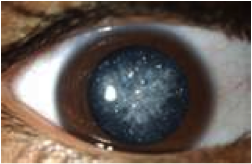CATARACT
Cataract – A cloudiness of the crystalline lens that may prevent a clear image from forming on the retina.
There are several patterns of cataract formation but the end result is the same. The greater the cloudiness, the worse the vision becomes until finally only light and dark can be distinguished.
The early stages of cataract may have no symptoms at all but early symptoms include glare sensitivity, reduced perception of fine detail and reading difficulties. Work and domestic activities become affected, and activities such as driving become impossible.
WHAT CAUSES CATARACT?
The main risk factor for cataract is age. The incidence of cataract rises rapidly from the age of 50-60 years old and keeps rising from there.
Other significant risk factors include family predisposition, eye trauma, diabetes and a history of dehydration in children from severe diarrheal infection and fevers.
Other lesser risk factors include the use of some drugs, the presence of other eye conditions, particularly inflammation in the eye and sunlight exposure.
Children and babies can have cataract and sometimes be born blind from it. This is called congenital cataract and is uncommon. When it occurs, early treatment is important to prevent a life of blindness.
TREATMENT
The treatment of cataract is surgical. During surgery the cloudy tissue has to be removed and then the replaced by a clear manmade lens called an intraocular lens or IOL.
Most cataract surgeries are done with a technique called phacoemulsification (small cut incision cataract surgery).
Under local anesthesia, a surgeon performing phacoemulsification makes a small opening on the side of your cornea. A device that sends out ultrasound vibrations is inserted into the eye and breaks the lens into small pieces. The fragments are then removed by suction through the small cut in the eye.
After the cataract is removed, the surgeon replaces it with a new, man-made lens called an intraocular lens. This procedure is called “intraocular lens implantation.”
The IOL is clear plastic, acrylic, or silicone with an optical power chosen by the surgeon to help restore normal vision, often minimizing the dependence on eyeglasses after surgery. This lens is permanent and doesn’t need any special care.
The IOL focuses light onto the retina to help improve your vision. If your natural lens is replaced with an intraocular lens, you may still need a new eyeglass prescription. However, most people can see fairly well at a distance without glasses after modern cataract surgery with a cataract lens replacement.

